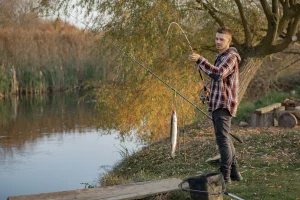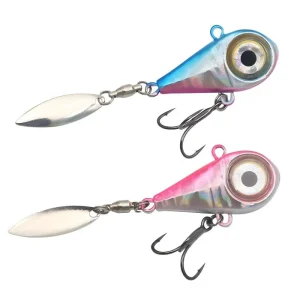
Fall bass fishing gets exciting when water cools to 55–70°F. Bass turn lively, chasing baitfish like shad into shallow spots and in-between areas. Good lures include crankbaits, spinnerbaits, and chatterbaits for searching wide spaces. Soft plastics like creature baits and Senkos, plus jigs, work great for careful fishing near cover. Pick lure size and color to match local prey and water conditions—natural shades for clear water, bright ones for cloudy. Change how fast you reel based on water temperature: quick above 60°F, slow below. Topwater lures shine in early fall. Later, switch to deeper baits as it gets colder. Use medium-action rods with fluorocarbon or braided line for top results.
How Does the Fall Season Affect Bass Behavior?
What Changes in Water Temperature and Seasonal Shifts Mean for Bass Feeding Patterns?
As summer fades into fall, bass get feisty. Cooler water and shorter days spark a change. Bass eat a lot to store energy for winter. When water hits 55–70°F, they swim more and hunt often. They chase baitfish like shad and bluegill. These fish move to shallow coves, creek arms, and flats. Bass follow them, hunting in groups near points, weeds, or rocky edges where they can surprise their prey.
Where Should You Focus Your Efforts When Targeting Fall Bass?
Look for in-between spots where deep water meets shallow flats. Current breaks near points and humps are good too. Creek mouths, sunken trees, and rocky banks hold fish in the fall. Bass swim closer to shore, chasing baitfish. Cast widely across these spots with moving lures to find them.
Why Is Bait Selection So Critical in Autumn?
How Can You Match the Hatch to Trigger More Strikes?
Matching the hatch means picking lures that look like the fish’s food. In the fall, shad are a big meal for bass. Silver or white lures that copy their shine and shape work well. This trick boosts your chances of catching fish.
How Do Water Clarity and Visibility Influence Lure Choice?
In clear water, common in fall, use natural-looking lures. Try see-through soft plastics or soft shad-pattern crankbaits. In muddy water from wind or lake changes, pick bright colors like chartreuse or dark shapes to stand out.
Are Bass Striking Out of Hunger or Instinct?
Bass strike for both reasons in the fall. They eat more to gain weight. They also snap at fast-moving lures that look like escaping prey. Use slow, careful methods for picky bites. Use fast, bold lures to spark quick attacks.
What Are the Best Moving Baits for Covering Water in Fall?
Why Are Crankbaits Ideal for Finding Active Fish Quickly?
Crankbaits let you fish big areas fast. They wiggle like baitfish running away. Use shallow crankbaits on flats. Try deeper ones near drop-offs or ledges where baitfish hide.
When Should You Choose Spinnerbaits Over Other Lures?
Spinnerbaits are great in windy or cloudy water. Their shiny blades and shaking motion draw bass. They work well around weeds or wood where bass wait to jump on shad schools.
How Do Chatterbaits Provide Versatility Across Depth Ranges?
Chatterbaits mix shine, shake, and a snag-free design. They work in shallow grass or deeper rock piles. Change trailers, like swimbaits or craws, to match what bass are eating and how active they are.
Which Soft Plastics Work Best for Finesse Tactics in Cooler Months?
Why Are Creature Baits and Craws Effective Near Bottom Structures?
Bass stick close to the bottom during cold snaps or weather shifts. Creature baits on Texas rigs or jigs move like crawfish when pulled slowly over rocks or brush. Jigging is a strong way to catch big bass. Crawfish crawl slowly, and jigs copy that motion well.
When Should You Use Senkos or Stick Worms With Minimal Action?
Stick worms, like Senkos, are perfect when bass are calm but still in shallow water. Rig them weightless or wacky style. They sink slowly with small twitches, ideal for fish near docks or fallen trees on tough days.
How Do Drop Shot Rigs Excel in High-Pressure Lakes?
When fishing is hard due to cold weather or lots of anglers, drop shots and Ned rigs keep lures in front of bass longer. These gentle setups don’t scare shy fish.
Are Jigs Still Effective as Temperatures Drop Further Into Fall?
Why Are Football Jigs Ideal Around Rocky Points and Structures?
Football jigs stay near the bottom, acting like crawfish moving over rocks. Their wide heads avoid snags and help you feel the bottom. This makes them great for late fall fishing. Drag them slowly to mimic crawfish crawling.
How Do Swim Jigs Mimic Baitfish Movement Perfectly?
Swim jigs glide smoothly through grass, looking like small fish. Keep a steady reeling speed with random twitches and pauses. This works when bass are hunting just below the surface.
Can Topwater Lures Still Produce Explosive Strikes During Early Fall Mornings?
What Makes Walking Baits and Poppers Irresistible at Daybreak?
In early fall mornings, when light is dim and temperatures are mild, topwater lures like walking baits make a splash. They draw big strikes from bass chasing baitfish near the surface.

When Should Buzzbaits Be Used Over Shallow Vegetation Beds?
Buzzbaits are great for covering big flats fast, especially over sunken weeds. Their loud buzz pulls bass from far away, even in slightly cloudy water.
How Should You Modify Your Techniques Based on Conditions?
Why Does Retrieval Speed Matter More Than Ever in Fall Fishing?
Cooler water slows bass down. Match your reeling speed to the water temperature. Fast retrieves work above 60°F. Slow down below 55°F, especially with jigs or soft plastics. For jigs over 14 grams, the fall is too quick. Use jigs under 10 grams for better control.
How Should You Choose Colors Based on Light Conditions and Forage Type?
On bright days, use natural colors. On cloudy days, pick bold ones like black-blue. Match lure colors to local prey, like silver-white for shad-heavy lakes.
When Is It Time to Change Lure Size Based on Bass Behavior?
If the bass nip or don’t bite, adjust lure size. Smaller lures work when fish are picky. Bigger ones stand out in crowded baitfish schools.
What Gear Works Best With Each Type of Lure During Fall Fishing Trips?
Which Rods And Lines Pair Best With Crankbait Presentations?
Medium-action rods with soft tips and fluorocarbon line (10–12 lb) are great for crankbaits. They give you a better feel and keep hooks in during fish fights. Weight matters more than color for these setups.
Why Is Braided Line Recommended For Topwater Applications Like Buzzbaits And Walkers?
Braided line has no stretch. This helps you set hooks fast with topwater lures. Timing is key when you see a strike and swing the rod.
Which Essential Lures Should Be Included In Your Fall Tackle Box Right Now?
Your tackle box needs moving baits like crankbaits, spinnerbaits, and chatter-style jigs. Add soft plastics like stick worms and creature baits. Include bottom lures like football jigs and gear for finesse rigs like drop shots. Laike’s premium lure collection has all these, designed for fall fishing. If you want to boost your catch rate this season, Laike’s tackle is built for shallow flats to deep cover. It’s tested to work in all fall conditions.
FAQ
Q1: What’s the best time of day to catch bass in the fall?
A: Early mornings and late afternoons are prime. Cooler temperatures and active feeding near the surface make these times the best.
Q2: Should I still use topwater lures after October?
A: Yes, if water stays above 55°F. When it gets colder, switch to deeper baits like jigs or soft plastics.
Q3: Can I use summer lures during the fall?
A: Some summer lures work if you adjust them. Slow down spinnerbaits, for example. Matching fall prey patterns gives better results.




